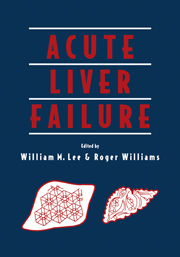Book contents
- Frontmatter
- Contents
- Preface
- Foreword
- Acknowledgments
- Contributors
- Part One Clinical Syndrome and Etiology
- Part Two Mechanisms of Disease and Multisystem Involvement
- Part Three Intensive Care Management
- Part Four Transplantation
- 14 Prognosis and consideration of transplantation
- 15 Liver transplantation in patients with acute liver failure: the European experience
- 16 Transplantation for acute liver failure: the American experience
- 17 Auxiliary liver transplantation
- Part Five Artificial and Bioartificial Liver Devices
- Part Six Other Applications
- Index
- Plate section
16 - Transplantation for acute liver failure: the American experience
from Part Four - Transplantation
Published online by Cambridge University Press: 20 May 2010
- Frontmatter
- Contents
- Preface
- Foreword
- Acknowledgments
- Contributors
- Part One Clinical Syndrome and Etiology
- Part Two Mechanisms of Disease and Multisystem Involvement
- Part Three Intensive Care Management
- Part Four Transplantation
- 14 Prognosis and consideration of transplantation
- 15 Liver transplantation in patients with acute liver failure: the European experience
- 16 Transplantation for acute liver failure: the American experience
- 17 Auxiliary liver transplantation
- Part Five Artificial and Bioartificial Liver Devices
- Part Six Other Applications
- Index
- Plate section
Summary
INTRODUCTION
For the patient in deep coma secondary to acute liver failure (ALF), liver transplantation offers the best chance for survival. As discussed elsewhere in this book, the prognosis of acute liver failure is highly dependent on many variables, including patient age and the etiology of liver failure. Nevertheless, when a patient progresses to deep stage III coma, the prognosis without transplantation in the absence of effective artificial support is grave.
The first American reports of liver transplantation for the treatment of acute hepatic failure were not very encouraging (Friend et al. 1989; Iwatsuki et al. 1989; Iwatsuki et al. 1985). Patients in these early series with acute liver failure had a one year probability of survival of about 50 percent, substantially lower than the 65–75 percent reported for those with chronic liver disease. For the most part, this high mortality was related to several factors, including late referral and an inability to identify those patients who, at the time of transplantation, had already suffered irreversible brain injury from the cerebral edema associated with acute liver failure.
INTRACRANIAL PRESSURE MONITORS
In 1986, based on previous experience with acute liver failure (Ede and Williams 1986) and with management of Reye's syndrome (Venes et al. 1978), we began using intracranial pressure (ICP) monitoring in the care of patients with acute liver failure (Schafer and Shaw 1989). In the first 31 of these patients, cerebral intracranial pressure monitor data was collected, but not used for selection of patients.
- Type
- Chapter
- Information
- Acute Liver Failure , pp. 201 - 210Publisher: Cambridge University PressPrint publication year: 1996



